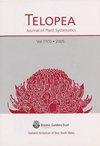Two new species of Genoplesium R.Br. sensu lato (Orchidaceae: Prasophyllinae) from the Central Coast of New South Wales
IF 0.5
4区 生物学
Q4 PLANT SCIENCES
引用次数: 1
Abstract
We describe two new species of Prasophyllinae from New South Wales, in the genus Genoplesium R.Br. following the generic classification currently in use at the National Herbarium of New South Wales. One of these new species, Genoplesium branwhiteorum M.A.M.Renner & P.H.Weston, which we name for the Branwhite family, has been known for nearly a decade under the informal name Corunastylis sp. Charmhaven (NSW896673). The other new species, G. geminatum M.A.M.Renner & Towle has been confused with both G. rufum (R.Br.) D.L.Jones & M.A.Clem. and G. trifidum (Rupp) M.A.M.Renner, although it is more similar to G. mucronatum (Rupp) M.A.M.Renner and G. tasmanicum D.L.Jones, and possesses a combination of features of consistent expression supporting its recognition as a new species. Three new combinations are made. Genoplesium cuspidatum (D.L.Jones & L.M.Copel.) M.A.M.Renner, comb. nov. is based on Corunastylis cuspidata D.L.Jones & L.M.Copel., Genoplesium laminatum (Fitzg.) M.A.M.Renner, is based on Prasophyllum laminatum Fitzg. and Genoplesium mucronatum (Rupp) M.A.M.Renner is based on Prasophyllum mucronatum Rupp. [listed as a synonym of G. rufum in PlantNet].标题根麻属二新种。产于新南威尔士州中部海岸的兰科植物
本文报道了来自新南威尔士州的二新种,属genplesium R.Br。按照新南威尔士州国家植物标本馆目前使用的一般分类。其中一个新物种,genplesium branwhiteorum M.A.M.Renner & P.H.Weston,我们将其命名为Branwhite家族,它在近十年来一直以非正式名称Corunastylis sp. Charmhaven (NSW896673)为人所知。另一个新物种G. geminatum M.A.M.Renner & Towle与G. rufum (r.b.r。d.l.琼斯和M.A.Clem。和G. trifidum (Rupp) M.A.M.Renner,尽管它与G. mucronatum (Rupp) M.A.M.Renner和G. tasmanicum D.L.Jones更相似,并且具有一致表达的特征组合,支持其作为新种的识别。形成了三种新的组合。虎杖草(D.L.Jones & L.M.Copel)M.A.M.Renner,梳子。《十一月》是基于Corunastylis cuspidata D.L.Jones & L.M.Copel。;;;;;;;M.A.M.Renner,是基于prophyllum laminatum Fitzg。而紫叶甘蓝(genplesium mucronatum, Rupp) M.A.M.Renner是基于紫叶甘蓝(Prasophyllum mucronatum Rupp)。[在PlantNet中被列为G. rufum的同义词]。
本文章由计算机程序翻译,如有差异,请以英文原文为准。
求助全文
约1分钟内获得全文
求助全文
来源期刊

Telopea
PLANT SCIENCES-
CiteScore
1.30
自引率
42.90%
发文量
0
期刊介绍:
Manuscripts submitted for publication in TELOPEA are published online, after peer review and acceptance by the TELOPEA Editorial Committee and when final editorial formatting has been completed. The journal specialises in plant systematics and phylogeny. The geographic scope of the journal encompasses Australia, Malesia, Melanesia, Micronesia, and Polynesia. The suitability of a work for the journal depends on the topic and the region of origin, generally the narrower the focus of the manuscript the closer to New South Wales must be its geographic focus.
As a general guide, we will consider:
1) revisionary treatments and other substantial bodies of work from any of the regions mentioned above.
2) new species from any Australian state.
3) new country records for Australia from any state.
4) new state records from New South Wales only.
However, we aim to support botanical research across the broader Australasian and Pacific region, and will consider submissions on their merit.
Generally we will not consider extraterritorial new country records, or single lectotypification papers unless they pertain to New South Wales taxa, or have significant bearing on the Australian flora.
 求助内容:
求助内容: 应助结果提醒方式:
应助结果提醒方式:


